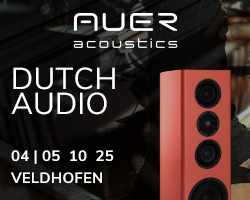 So, what happens when you give the designers at PMC, a company known for its monitor speakers and strong links with pro audio, complete freedom to design a new, flagship pair of speakers? Well that’s what we were dying to find out as we made our way into the packed press conference in the PMC room at the MOC Munich on Thursday. We were expecting something pretty special as the new speakers were being hyped as PMC’s most significant launch since the BB5 in the early 90’s.
So, what happens when you give the designers at PMC, a company known for its monitor speakers and strong links with pro audio, complete freedom to design a new, flagship pair of speakers? Well that’s what we were dying to find out as we made our way into the packed press conference in the PMC room at the MOC Munich on Thursday. We were expecting something pretty special as the new speakers were being hyped as PMC’s most significant launch since the BB5 in the early 90’s.
A three-way, “ultra-high-resolution” passive twin ATL™ loudspeaker, fenestria incorporates all-new, tailor-made drivers, twin Laminair™ vents for improved aerodynamic ATL airflow, plus a newly designed cabinet that houses the treble and mid-range units in an “innovative and elegant reflection-free module”.
PMC say that fenestria (meaning, appropriately, window) is, “the loudspeaker that you will never hear”. A pretty big claim in anyone’s book, so did the fenestria do what we are often looking for in a loudspeaker, and simply open the window and disappear? “fenestria is the perfect example of our holistic design approach,” explains Peter Thomas, PMC’s owner and chief designer. “Our aim was to make the best passive loudspeaker we could, with an open mind when it came to technologies and materials. We looked at all options to achieve the purest, most transparent sound, and fenestria was the result.”
Keith Tonge, being master of the press conference (he tells you briefly what you need to know and then gets some music playing, many could learn from him) filled us in on the technology involved in the speakers that were revealed from behind black curtains. Drawing on airflow technologies usually employed in motor sports and stabilising techniques that generally stop buildings collapsing in earthquake prone countries, and using new kinds of carbon fibre never previously employed in loudspeakers, the fenestrias are unmistakably PMC, but with something more.
Admittedly, show conditions are not the best to demo speaker capabilities, but the challenge did not seem to bother the fenestrias in the slightest. They had the directness that you’d expect from PMC, I always find that their speakers have an honesty to how they deliver the music. They are incredibly fast with the bass sounding very nimble but with plenty of guts, they also seemed refined but not in an overly polite way, ‘well groomed’ is probably a good description. They also look very high end with an impeccable finish and the new central ‘nest’ arrangement (made from a solid billet of aluminium, isolated and decoupled from the rest of the cabinet) adding a new level of detail both in the sound of the tops and mids and the visual impact of the speakers.
I suppose the fenestrias are a bit of a contradiction. They are not ashamed to show their deep musical roots and heritage but certainly have a touch of class about them…if they were taking you on a night out you would most likely have a really great meal with some well-chosen wines, and then end up shaking your ass in a dark and dingy techno club somewhere until the sun comes up.
And what do these new PMC flagships cost? I’ll admit, I was expecting somewhat more than their £45,000 (54,000€). Munich does tend to bring the ‘lottery winning’ priced gear out but the fenestria seemed pretty reasonable for what you are getting…especially when you listen to other, much more expensive speakers at the show and conclude that the PMC fenestrias don’t just hold their own, they positively, and I’m putting this as politely as I can, ‘wee all over’ much of the competition.
Technical Details
Fenestria is 1.7m tall and features a 19.5mm Sonomex™ high frequency unit with a neodymium magnet assembly and PMC-designed dispersion grille. The driver is isolated from the midrange unit and nest with a silicone-damped PMC suspension mount, the Auriole™.PMC’s midrange driver in fenestria is a wholly new 75mm unit. The four 165mm long-throw piston bass drivers each feature a massive magnet assembly and a flat diaphragm comprising two layers of transverse-weave carbon-fibre, hand made by a specialist motor sport manufacturer, sandwiching a rigid multi-cellular damped core.

Oliver Thomas, PMC’s R&D Manager talks technical with Hifi Pig’s Janine Elliot at the High End Munich fact fenestria launch.
Also shared with the world of auto sport are the Laminair™ vents situated at the end of the twin Advanced Transmission Lines (ATL), PMC’s proprietary bass-loading technology. Using principles of aerodynamics used from F1 to Le Mans, the Laminair vent creates a smooth, laminar airflow as it exits the ATL. Housing the ATL and bass units are the heavily braced cabinets, which are acoustically isolated from the drivers in the nest. Such is the high energy produced by the bass drivers and twin ATLs, a more innovative approach was required to preventing unwanted low-frequency vibrations from passing into the cabinet. Using the same techniques employed in tall buildings to prevent earthquake damage (whereby a high-mass pendulum is added to the structure), the sides of fenestria’s cabinet have been engineered to resonate in opposition to the rest of the loudspeaker assembly. The result is the elimination of vibrations before they leave the cabinet – the side panels cancel out all the unwanted energy produced by the drivers. The crossover, situated in the speaker’s plinth, is also acoustically isolated from the rest of the cabinet. The plinth also houses the high and low-frequency tuning controls. The PMC Fenestria is available in White silk, Rich walnut, Graphite and Tiger ebony finishes.
Linette Smith
Read all the High End Munich 2018 coverage here!







































































































































































































You must be logged in to leave a reply.